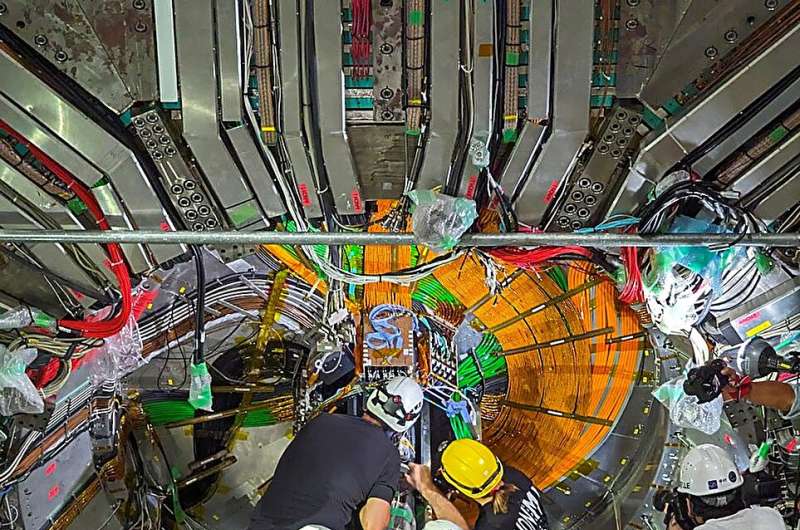The Daily Observer London Desk: Reporter- John Furner
The Belle II cooperation project at the Japanese research center KEK is helping researchers from all over the world to hunt for new phenomena in particle physics. The international experiment has now reached a major milestone after a team successfully installed a new pixel detector in its final location in Japan.
The size of a soda can, the detector was developed in order to make out the signals coming from certain types of particle decays, that can shed light on the origin of the matter–antimatter asymmetry that has been observed in the universe. The installation ran without a hitch and is a key milestone in the evolution of the experiment and German–Japanese research collaboration.
Based at the SuperKEKB accelerator in Japan’s KEK research center, Belle II is an international collaborative project involving researchers from all over the world. The experiment aims to find answers to the many unresolved questions about the universe that are out there. To this end, the 1,200 or so members of the international Belle II collaboration are searching for signs of new phenomena in physics and unknown particles not covered by the established Standard Model of particle physics.
Installation also marks the end of a long journey for the detector. Starting out in Munich, its components traveled across the country via several German institutes, including the University of Bonn, before ending up in Hamburg at the Deutsches Elektronen-Synchrotron (DESY), where they were assembled. The final step was an eastward trip of several thousand kilometers to Japan and Belle’s II ultimate destination, the SuperKEKB electron-positron collider.
The journey by air brought new challenges of its own: any sudden turbulence or improper handling in transit could easily have broken one of the highly sensitive sensors, so a case built specially for the occasion protected the detector to minimize vibrations and it got its own seat in business class.
Members of the University of Bonn had a major hand in installing the detector in Japan. “The installation of the pixel detector was extremely satisfactory, without any significant difficulties,” says Botho Paschen, Technical Coordinator of the pixel detector project and a researcher at the University of Bonn. He put the success down to the hard work and dedication of an exceptional team that has spent years developing the detector and preparing it for installation.
The process proved extremely challenging, due particularly to the very tight space. Says Paschen, “The next important step is to put the detector into operation so that we’ll be able to start recording new collision data in early 2024.”

Prof. Dr. Florian Bernlochner, Belle II Group Leader at the University of Bonn, stressed the importance of the new detector for the experiment’s physics objectives. “The pixel detector is the key instrument for enabling the lifetimes of heavy quarks to be measured accurately. These measurements will allow us to investigate the violation of one of the most fundamental symmetries in nature—charge-parity symmetry—in more detail.”
The violation of this symmetry is one of three preconditions that have to be met in order to explain why the universe currently consists almost exclusively of matter. “Belle II will give us an even more precise understanding of why matter and antimatter behave differently and whether as-yet undiscovered particles or forces play a role in the decay of heavy quarks,” Bernlochner adds.
The decay products of heavy quarks possess relatively little energy and are easily disturbed when they pass through the detector material. This meant that the detector elements closest to the collision point of the particle beams on the Belle II have to be as lightweight as possible, making the pixel detector extremely fragile and its installation highly challenging. The detector is made up of 20 silicon strips 75 micrometers thick, the same width as a human hair.
The ultra-thin DEPFET (DEPleted Field Effect Transistor) sensors were designed in the Max Planck Society’s semiconductor laboratory. The strips are arranged in two concentric cylindrical layers, the innermost of which is only 1.4 cm away from the beam line. Following the successful installation, say the team, Belle II is now equipped with the thinnest pixel detector in the world.
The innovative detector is designed to supply up to 50,000 high-resolution images a second of the decaying heavy quarks, which are produced in abundance at the SuperKEKB. The pixel detector’s DEPFET sensor technology can also be used for a range of other purposes, such as X-ray satellite missions, the hunt for sterile neutrinos or dark matter, and medical imaging.
Researchers measuring the structure of matter on ultra-small length scales need ever more powerful detectors, and the Research and Technology Center for Detector Physics (FTD) at the University of Bonn offers them the perfect environment for this, complete with cutting-edge infrastructure.
The FTD is also home to the University of Bonn’s Silicon Lab (SILAB), where the modules for the pixel detector were vigorously tested and its capabilities studied in detail over a period of several years. “The detector’s successful installation is the result of many years of fruitful collaboration between the institutions and research centers involved,” says FTD Co-Speaker and SILAB Director Prof. Dr. Jochen Dingfelder, who played a key role in developing the pixel detector over many years together with Prof. Dr. Norbert Wermes.
“I’m delighted to see how our concerted efforts have produced such a groundbreaking achievement.” The team from the University of Bonn would like to thank everyone involved from Japan, Europe and Germany for their hard work and commitment.


